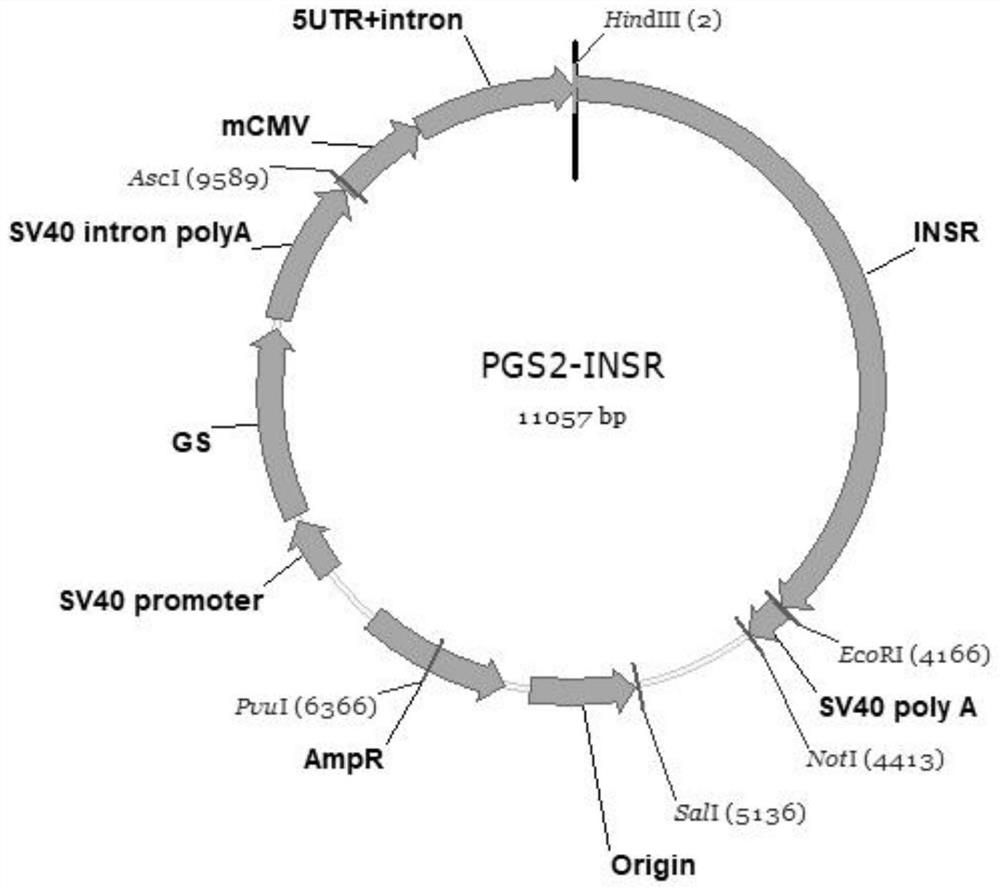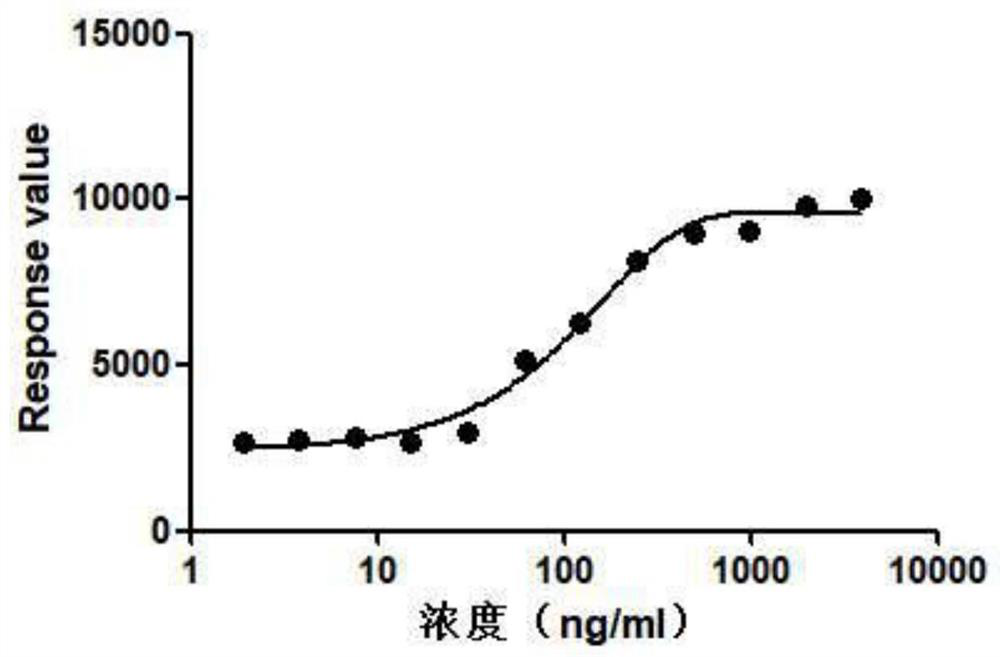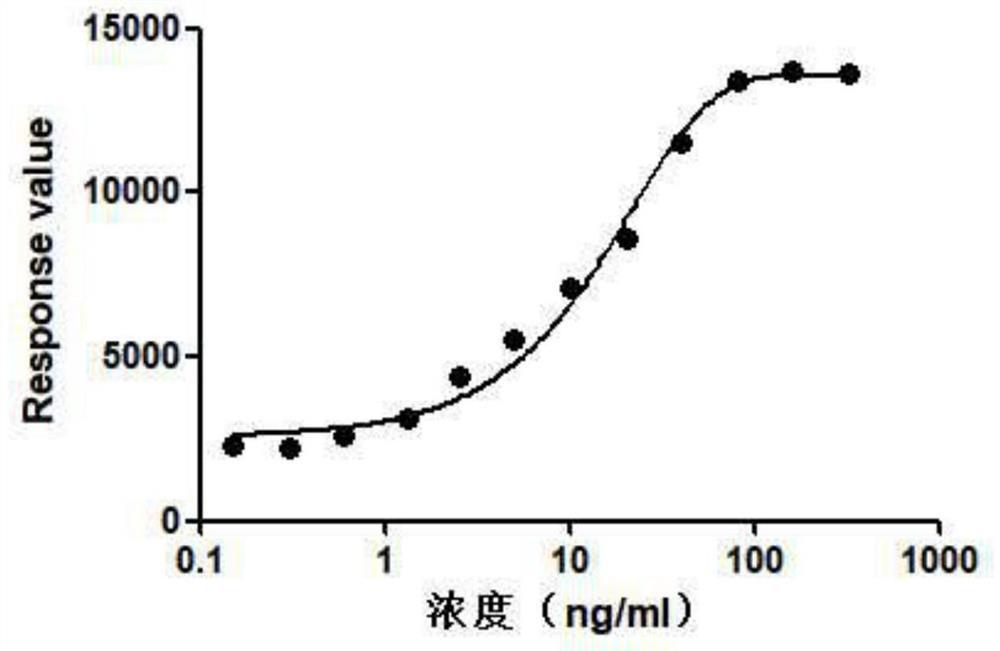Insulin receptor protein expression cell strain and application thereof
A technology of cell lines and human insulin, applied in the application, cells modified by introducing foreign genetic material, using vectors to introduce foreign genetic material, etc., can solve the problems of cumbersome operation, large differences, and low sensitivity of the method, and achieve repeatability Good, low cost, easy standardization effect
- Summary
- Abstract
- Description
- Claims
- Application Information
AI Technical Summary
Problems solved by technology
Method used
Image
Examples
Embodiment 1
[0031] Example 1 Synthesis and construction of expression INSR vector
[0032] 1. Amplification and identification of the INSR gene
[0033] The sequence of human INSR protein is shown in SEQ ID NO: 1, with a full length of 1382 amino acids. The sequence optimization and full-length DNA synthesis were commissioned to the outside world, and a Hind III restriction enzyme cleavage site was added to the N-terminal of the nucleotide sequence encoding the human INSR protein. and kozak sequence, adding a terminator TGA and an ECORI restriction site at the C-terminus, and the optimized full-length nucleotide sequence is shown in SEQ ID NO: 2. The full sequence gene was synthesized and then ligated into PUC-57 vector to construct PUC57-INSR vector.
[0034] Both the PUC57-INSR plasmid and the vector PGS2 were digested with restriction enzymes HindIII and ECORI, and the target fragment was recovered, ligated with T4 ligase, ligated at 16°C overnight, and the ligated product was transfo...
Embodiment 2
[0038] Example 2 Analysis of expression of INSR activity in CHO-K1-INSR-6B3, CHO-K1-INSR-2A4 and CHO-K1-INSR-3B1 cells
[0039] Insulin and its analogs, after binding to insulin receptors, phosphorylate at Tyr1150 / 1151 of downstream β receptors, and the kit provided by CISbio can specifically detect the phosphorylated β receptors by sandwich ELISA method, an antibody Label the Eu3+ hole, another antibody labels d2, which is phosphorylated after insulin and analogs bind to the receptor. The higher the activity, the higher the phosphorylation level. After cell lysis, the phosphorylated β receptor is released, and the Eu3+ hole is labeled. The antibody (donor) and the D2-labeled antibody (acceptor) can specifically bind to the phosphorylated β-receptor, when the two antibodies bind to the phosphorylated β-receptor, when the dyes are in close proximity , the light source (laser or flash lamp) excites the donor to emit fluorescence resonance energy transfer (FRET) to the acceptor, ...
Embodiment 3
[0044] The detection of embodiment 3 insulin biological activity
[0045] The IR beta phosphor-Y1150 / 1151 kit was used for detection, and CHO-K1-INSR-6B3 cells were suspended in PBS at 5×10 5 1 ml, 50 μL / well, added to a 96-well plate, starved for 2 hours. 2-fold dilution of different insulins in PBS (insulin aspart (300 units / 3ml / vial), insulin glargine (300 units / 3ml / vial), insulin detemir (300 units / 3ml / vial)), 10 μL / well, added to The treated cells were starved for 20 min. After stimulation, immediately add the lysis working solution mixed with blocking reagent and 4× lysis solution at a ratio of 1:24, 20 μL / well, lyse at room temperature for 30 min, 150 rpm / min. After the lysis is completed, mix well, transfer 16 μL to a 96 shallow-well plate, and then add 4 μL of the pre-mixed antibody working solution (the two working antibodies and the detection buffer are mixed at 1:19, and the two diluted working antibodies are used before use. Mix again at 1:1), and incubate at r...
PUM
 Login to View More
Login to View More Abstract
Description
Claims
Application Information
 Login to View More
Login to View More - R&D Engineer
- R&D Manager
- IP Professional
- Industry Leading Data Capabilities
- Powerful AI technology
- Patent DNA Extraction
Browse by: Latest US Patents, China's latest patents, Technical Efficacy Thesaurus, Application Domain, Technology Topic, Popular Technical Reports.
© 2024 PatSnap. All rights reserved.Legal|Privacy policy|Modern Slavery Act Transparency Statement|Sitemap|About US| Contact US: help@patsnap.com










